|
DESCRIPTION AND DATA OF
BASIC KIT
Jungle Uniform, Jacket/Trousers
Three main
type of jungle jackets were used
during the Vietnam War, the main
difference being as follows.
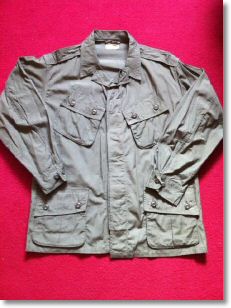
1st
pattern,
poplin material, with exposed
buttons, jacket with shoulder
straps, side tabs and neck gas
flap, trousers with button fly,
leg ties and button waist tabs
|
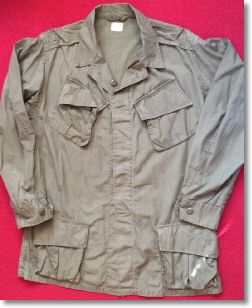
2nd
pattern,
jacket and trousers
identical to above but with
concealed buttons
|
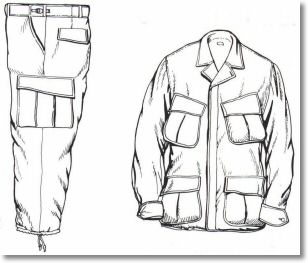
3rd
pattern, type A
in poplin, concealed buttons, no
shoulder straps, no side tabs,
no gas flap, trousers button or
zip fly, no leg ties and buckle
waist tabs.
3rd
pattern, type B
identical but made of rip stop
material, trousers zip fly, no
leg ties and buckle waist tab
|
The most
common one was the 3rd pattern rip stop,
if you use the earlier types,
make sure you are not depicting
a time frame before the Vietnam
issue time
|
The
"Old
Timer" says
The
real stuff is still
around but price do vary
a lot,
so
good reproduction
uniforms are now
acceptable
as long as
approved by the committee.
*
Please
fill up your pocket when
representing field
troops. |
 |
UNDER GARMENTS
Military
underwear is not essential,
although most members do wear
them. Standard issue T-shirts
had crew necks should be Olive
Drab. (See photo bellows)
Old white t-shirts are OK
for early stuff (up to 1965)
(don't forget you would have
made a nice target with them!)
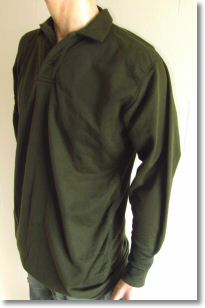
The Nylon
Sleeping shirt was introduced in
1966. This was designed to
replace the sweater and was
quick drying
(desirable but not a requirement).
HATS
Cap,
field, hot weather, OG-106,
generally not liked by the
troops. In
country tailors made were often
purchased as their slightly
different shape was preferred.
|
The
"Old
Timer" says
Watch out for post
the war cap
with only four
vent holes instead of six.
*
(These are not acceptable)
|
 |
Jungle hat
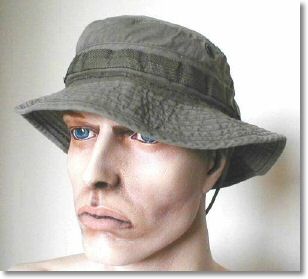 |
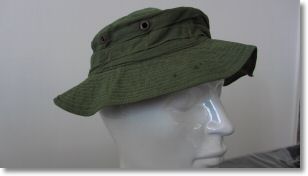
|
|
Hat,
jungle with insect net,
(the
much loved boonie hat),
standard
issue from summer 1967 onwards.
|
Vietnamese made
version in light weight
poplin
bonnie hat,
brought back by the same
Seabee
as T shirt above |
BOOTS
Three patterns of
jungle boots were produced
during the Vietnam War, with the
3rd pattern
(see photos) being
distributed from 1967 onwards.
The first jungle boot arrived in
1962/63 and the 2nd
pattern in late 1965. Prior to
early 1966, the most common boot
in Vietnam was the black leather
combat boot. The black leather
combat boot remained in use
throughout the war for flying
personnel for safety reasons.
Black
leather and green canvas US
issue jungle boots for all
members (preferably 60's but
80's OK),
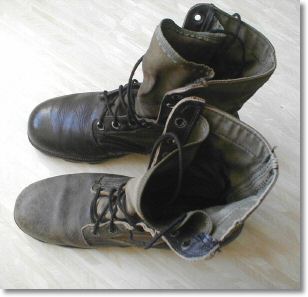
The
one on left is a 1985 US Issue,
the one on the right with the
seam on the heel is dated 1968
and is the 3rd
pattern with the panama sole
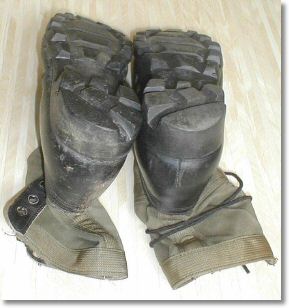
The
top boot is polished and as worn
by Base assigned personnel.
The lower one is grey and dry as
worn by field troops. Boots
would nearly turn kind of a
greyish/tan colour if not
polished regularly.
|
The
"Old
Timer" says
All
60ís jungle boot have
vertical seam running up
the heel, the post war do
not have but they are
acceptable
as
long as approved by
the committee.
Beware of some poor
quality copies.
*
Also the 60ís
all leather boot should
not have a relief cut in
the lacing area at ankle
height, but again the post
war are acceptable
as
long as approved by
the committee.
.
|
 |
Equipment,
Helmet
M1
helmet with correct liner and
green canvas straps
(not nylon, no Bundeswehr
helmet/liner). This must be
covered with wine tree/frog and
leaf helmet cover, with
virtually no graffiti.
You should have the
narrow green helmet band with
only few items sensibly attached
to it.
(Acceptable, bug juice, C rat
toilet paper or matches,
cigarettes).
Here
are some items you can carry in
your helmet band,
TOP: cigarette pack, toilet
paper and matches (all out of
60's ration packs)
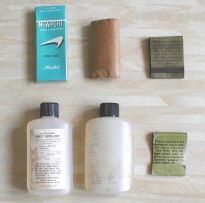
BOTTOM:,
two different bottles of bug
juice,
The matches on the bottom right
are from a modern MRE and are
not acceptable.
|
The
"Old
Timer" says
Helmet
cover graffiti was
used in the later
part of the war
and often depicted in war
films!
This still was not
generalised so if you do
go for that look,
donít over do it!
Make sure
that your unit don't
end up looking like
a Vietnam graffiti
art gallery |
 |
INSIGNIA
A
lot of combat troops in the field tended not
to wear insignia on their
uniforms.
However if you do want
to wear some, they must be the
proper U.S. Army issue twill or
Ďlocalí Vietnamese-made for
the subdued types patches.
Colour
insignia were only worn early in
the war, except for 101st, 82nd
Airborne, and the 1st Inf Div
which retained their colour
insignia throughout the war. This
is not to say that they did not
wear subdued shoulder
patch!
The subdued
shoulder patch version was
authorised for wear from June
1966, with most units achieving
the changeover by the end of
1967.
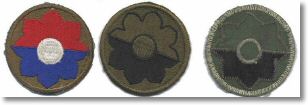
Full colour, merrow type subdued, Vietnam
made
subdued
Pin
on rank insignia was authorised
in the summer of 1967 and a
mixture of pin on and subdued
sleeve rank insignia will be
seen until the end of the war.
The merrow edge type
patches started to appeared in
small quantity from around 1969 onwards and are not a good
representation of the patches
used during the Vietnam
war.
The full colour
version merrow edge would be
acceptable for a late war Dress uniform, but again they do not reflect the type of
insignia worn during the war.
The
Cut edge, twill or Vietnamese
made are much accurate options.
To
help you out, a detailed photo
of different types of
manufacture is shown.
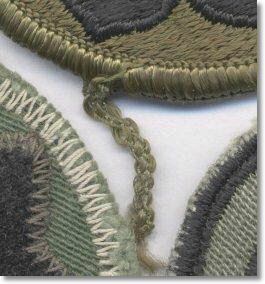
Top
is the merrow edge recognised by
its thread tail.
Right is the US twill type with a cut edge.
Left
is a Nam-made one, which is of
similar construction to the
twill but with various backings
and of various quality.
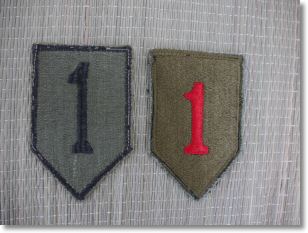 |
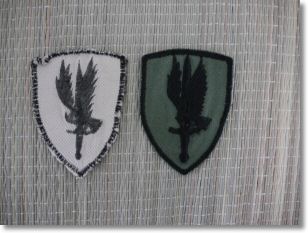 |
| 1st
Infantry Nam made subdued
and cut edge green
backing US made |
1st
Aviation Brigade subdued
Nam made and early twill |
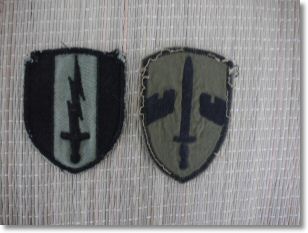 |
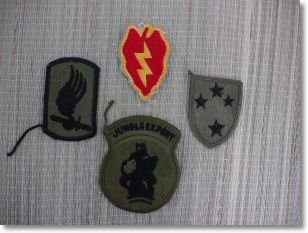 |
| Early
twill 1st Signal brigade
and Nam made MACV |
25th
Inf Div cut edge full
colour, rest are merrow
edge,
with 173rd Airborne
Brigade, Jungle Expert
badge
and Americal |
What
often people refer as in "Country
made" or Vietnam made
insignia were not only made in
Vietnam, but all over South East
Asia where ever US troops
where, there construction can
some time be identified as where
they were made.
They also came in many different
qualities as you could go to you
local "Mama San with a
sewing machine"
or to taylor shop like"
Cheap Charlie in Saigon and get
any patch made.
To further complicated things,
from the early 70's (during the
war), Vietnamese tailors started
producing patches for the US
Military Patches Collectors,
which were purchased by Merchant
Navy personnel for resale in the
US or for their own collection.
From the late 80's and early
90's once genuine war time made
patches started to dry up, the
same Vietnamese Tailors that
used to produce patches during
the war started again producing
patches for the growing
collector marquet with the same
machines that they had used
during the war.
To even had further to the
difficulty in identifying
a genuine patch from a copy, the
genuine patches have many
different constructions as to
when, where and by who they were
made. Patches collectors can
acquire a feel for spotting
fakes or genuine one ones but
there is not an infallible rule
and many post Vietnam war
patches made in South East Asia
have inadvertently entered
individual Genuine collections
as well as genuine War time
patches being now questioned as
been authentic!
|
The
"Old
Timer" says
Prior to
April 1965, the white name
tag and the black on gold
US ARMY tapes were worn.
During the next two years,
they were gradually
replaced by the subdued
version. Post 1967, subdued
insignia only! |
 |
Vietnamese-made
name tapes and
US
name
tapes
|

|

|
|
Subdued
Vietnamese made tapes are
most representative of Vietnam war |
|

|

|
|
Subdued
US-made
embroidered or printed name and
US tapes appeared from around 67 onwards
and would have been obtained in
the US before deployment
|
|

|

|
|
US
made nylon tapes, appeared in Vietnam
from around
69, again in small
quantity
and are best avoided unless you
are doing very late war.
|
|
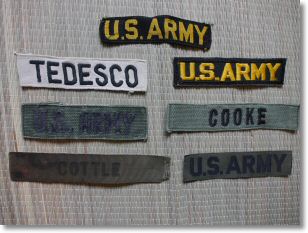
|
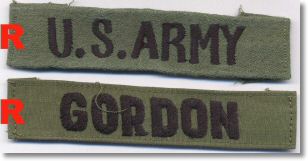
|
|
Missing from the
photo on the left is the
the subdued twill issue
US ARMY tape
(photo to
be posted later on) |
Asian made tapes
above
|
|
The
"Old
Timer" says
Tapes
position:
Prior to Feb 1968, tapes
were worn either at an
angle or parallel to the
floor,
Feb 68 to Sep 69
parallel to the ground
and
from Sept 69 at an angle
for better visibility.
NO
NYLON TAPES OR
GERMANS/BRITISH NAME TAPES
|
 |
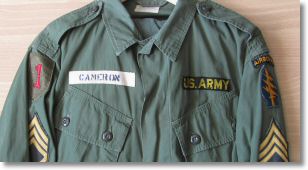
SF first pattern
jacket showing US
made
full colour insignias
Printed white name
tape |
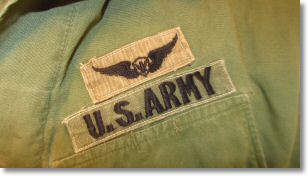
Post 69 tape position
Nam made |
|
The
"Old
Timer" says
Wear the right gear for whatever mission you are
supposed to be on. Don't
stand on base guard duty with a
machete, rucksack or butt pack!
When you wear a ruck or ammo
pouches, make sure they are
full.
Again do your research
and check what your unit was
wearing during the specific
period you are depicting.
Think
like a soldier and act
like one!
|
 |
|